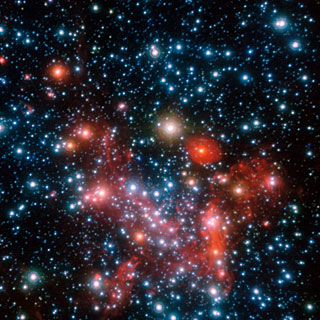







| BOOKS | F. A. Q. | ARTICLES | TALKS | ABOUT KEN | DONATE | BEYOND OUR KEN |
|---|
By Ken Croswell
Published on Physics World (February 10, 2011)

The Galactic Center. Credit: ESO/S. Gillessen et al.
Cosmologists can rejoice: they'll still be able to do their jobs a trillion years from now--even after the universe's expansion has pushed nearly all galaxies out of sight. That's the conclusion of an astronomer in the US, who argues that the giant black hole at the center of our Galaxy will eject stars into the void beyond, providing objects that future cosmologists can use to trace the universe's expansion.
Ever since the late 1990s, when astronomers used supernova explosions in distant galaxies to discover that the universe's expansion is accelerating, the far future of cosmology has seemed bleak. Within roughly 100 billion years, nearly all other galaxies will be so distant that their light won't reach us. As a result, future observers won't know that the universe is expanding. Furthermore, the cosmic microwave background--which is the big bang's afterglow and a key clue to the universe's origin--will be attenuated below the threshold at which it can be detected.
In October 2010 Abraham Loeb gave a public talk at the Harvard-Smithsonian Center for Astrophysics in Cambridge, Massachusetts, in which he recounted these difficulties. "People were very intrigued and came to me afterwards," says Loeb, who is professor of astronomy at Harvard University. "Someone said, `Why don't you write an article about that?' And I said, `Well, I'll think about it,' and then when I thought about it I realized that it's wrong: there will be a way in the distant future to verify the standard cosmological scenario that we now have."
The keys to Loeb's proposal are so-called hypervelocity stars. In 1988 Jack Hills, then at Los Alamos National Laboratory in New Mexico, said that if a double star skirted close to the giant black hole at the Milky Way's center, one star in the pair could fall toward the black hole. This star would lose an enormous amount of energy, and by the principle of conservation of energy its mate would gain enormous energy and fly away at high speed.
Then, in 2005, Warren Brown of the Harvard-Smithsonian Center for Astrophysics and his colleagues announced the discovery of the first hypervelocity star. Astronomers have since spotted more than a dozen others. "These hypervelocity stars will save the day," says Loeb. That's because, even a trillion years from now, the black hole at the Galaxy's center will still be ejecting stars. These stars will probably be red dwarfs, dim suns that can live for trillions of years. By tracking the motions of these stars after they leave the Galaxy, astronomers can deduce the universe's expansion.
Long before then, Loeb expects the Milky Way to merge with the Andromeda Galaxy, 2.5 million light-years away, producing an even greater galaxy he calls "Milkomeda." As a hypervelocity star leaves Milkomeda, the galaxy's gravity first slows it down. But eventually the accelerating universe speeds the star up. "By monitoring the motion of these stars, a future cosmologist could infer the existence of the cosmological constant," explained Loeb. The cosmological constant represents the repulsive force of empty space; it's what's causing the cosmic expansion to accelerate.
The more mass Milkomeda has, the farther is the distance at which the universe's expansion will manifest itself. If Milkomeda has 2 trillion times the mass of the Sun, Loeb calculates this transition distance occurs 4.4 million light-years from us. If instead Milkomeda has 10 trillion solar masses, then this transition distance is 7.5 million light-years.
However, Lawrence Krauss at Arizona State University in Tempe, who had earlier considered the potential of hypervelocity stars, is skeptical. "Right now, with supernovae--the brightest objects in the universe--we're barely able to discover the existence of a cosmological constant," says Krauss. "To propose that you can use individual stars to measure the expansion of the universe--it may be barely physically possible, but is it likely?" Krauss thinks not, that a civilization a trillion years from now would probably consider Milkomeda and its satellite galaxies to be the entire universe, surrounded by a static void, and would have no incentive to spend vast sums of money tracking subtle changes in the velocities of a few dim and distant stars.
Loeb counters that these stars will be a thousand times closer than today's farthest supernovae and that a civilization will have a trillion years to develop a giant telescope to study the escaping stars.
Loeb wrote his paper in January, after a major snowstorm hit New England. "It allowed me not to be interrupted, not to be distracted," he says. He has since submitted his work to Physical Review D.
Ken Croswell is an astronomer and the author of The Lives of Stars.
"A stellar picture of what we know or guess about those distant lights."--Kirkus. See all reviews of The Lives of Stars here.
| BOOKS | F. A. Q. | ARTICLES | TALKS | ABOUT KEN | DONATE | BEYOND OUR KEN |
|---|